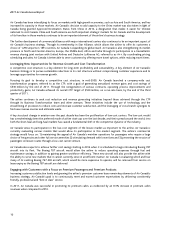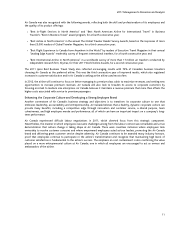Air Canada 2011 Annual Report Download - page 20
Download and view the complete annual report
Please find page 20 of the 2011 Air Canada annual report below. You can navigate through the pages in the report by either clicking on the pages listed below, or by using the keyword search tool below to find specific information within the annual report.2011 Air Canada Annual Report
20
Airport and navigation fees increased 5% from 2010
Airport and navigation fees amounted to $1,007 million in 2011, an increase of $46 million or 5% from 2010. This increase
was mainly due to a 2.5% increase in aircraft departures, the impact of changes in schedule and aircraft types operated to
certain destinations and to an increase in terminal user fees, effective April 1, 2011, at London Heathrow Airport. Costs
associated with Air Canada’s new services operated by Sky Regional between Billy Bishop Toronto City Airport and Montreal
Trudeau Airport were also contributing factors to this increase.
Capacity purchase costs increased 3% from 2010
Capacity purchase costs amounted to $1,003 million in 2011 compared to $971 million in 2010, an increase of $32 million or
3%. This increase was mainly due to higher Jazz CPA rates, increased flying by Jazz, and costs associated with Air Canada’s
new services operated by Sky Regional between Billy Bishop Toronto City Airport and Montreal Trudeau Airport. Partly
offsetting these increases was the favourable impact of foreign exchange on U.S. currency denominated Jazz CPA charges
paid by Air Canada, which accounted for a decrease of $13 million in capacity purchase costs in 2011. In addition, in 2010, Air
Canada recorded a charge of $7 million related to Jazz covered aircraft returns while no such charge was recorded in 2011.
Ownership costs decreased 8% from 2010
Ownership costs, which are comprised of depreciation, amortization and impairment, and aircraft rent expenses, of
$1,063 million in 2011 decreased $91 million or 8% from the same period in 2010. This decrease was largely due to Air
Canada having recorded an impairment charge of $49 million relating to Airbus A340-300 and Boeing 767-200 aircraft in
2010 while no such charge was recorded in 2011. Other contributing factors included the favourable impact of a stronger
Canadian dollar versus the U.S. dollar, which reduced aircraft rent expense by $18 million, the impact of lower rates
associated with leased Airbus A320 aircraft, as well as decreases in software amortization costs and depreciation expense on
rotable aircraft parts. Costs associated with the airline’s new services between Billy Bishop Toronto City Airport and Montreal
Trudeau Airport partly offset these decreases. The $73 million decrease in depreciation, amortization and impairment expense
was essentially in line with the decrease of $75 million projected in Air Canada’s news release dated November 4, 2011.
Aircraft maintenance expense increased 4% from 2010
In 2011, aircraft maintenance expense of $681 million increased $27 million or 4% from 2010, of which $20 million was due
to changes in cost and discount rate assumptions for provisions related to end of lease maintenance return conditions. A
higher volume of engine maintenance events and an increase in maintenance cost obligations related to aircraft lease
terminations were also contributing factors to the increase in aircraft maintenance expense versus 2010. Partly offsetting
these increases were a decrease in components maintenance activity and the favourable impact of a stronger Canadian dollar
on U.S. currency denominated maintenance expenses. The 4% increase in aircraft maintenance expense was in line with the
increase of 4.0% to 5.0% projected in Air Canada’s news release dated November 4, 2011.
Sales and distribution costs increased 5% from 2010
In 2011, sales and distribution costs of $612 million increased $31 million or 5% from 2010. Factors contributing to the year-
over-year change in sales and distribution costs in the full year included:
The passenger revenue growth of 8.3%;
An increase in credit card fees which was due to higher passenger sales and an increase in the percentage of sales made
on credit cards; and
An increase in sales and distribution costs at Air Canada Vacations which was due to a change in commission structure
and higher passenger sales.
Food, beverages and supplies expense decreased $1 million from 2010
In 2011, food, beverages and supplies expense of $278 million decreased $1 million from 2010. The impact of growth in
passenger traffic, including in the premium class cabin, was offset by the favourable impact of cost reduction initiatives, most
of which are related to contract and process improvements.
Other operating expenses increased 3% from 2010
Other operating expenses amounted to $1,230 million in 2011, an increase of $36 million or 3% from 2010.
























